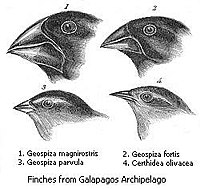
Photo from wikipedia
Abstract Cichlid fishes of the tribe Tropheini are a striking case of adaptive radiation, exemplifying multiple trophic transitions between herbivory and carnivory occurring in sympatry with other established cichlid lineages.… Click to show full abstract
Abstract Cichlid fishes of the tribe Tropheini are a striking case of adaptive radiation, exemplifying multiple trophic transitions between herbivory and carnivory occurring in sympatry with other established cichlid lineages. Tropheini evolved highly specialized eco‐morphologies to exploit similar trophic niches in different ways repeatedly and rapidly. To better understand the evolutionary history and trophic adaptations of this lineage, we generated a dataset of 532 targeted loci from 21 out of the 22 described Tropheini species. We resolved the Tropheini into seven monophyletic genera and discovered one to be polyphyletic. The polyphyletic genus, Petrochromis, represents three convergent origins of the algae grazing trophic specialization. This repeated evolution of grazing may have been facilitated by adaptive introgression as we found evidence for gene flow among algae grazing genera. We also found evidence of gene flow among algae browsing genera, but gene flow was restricted between herbivorous and carnivorous genera. Furthermore, we observed no evidence supporting a hybrid origin of this radiation. Our molecular evolutionary analyses suggest that opsin genes likely evolved in response to selection pressures associated with trophic ecology in the Tropheini. We found surprisingly little evidence of positive selection in coding regions of jaw‐shaping genes in this trophically diverse lineage. This suggests low degrees of freedom for further change in these genes, and possibly a larger role for regulatory variation in driving jaw adaptations. Our study emphasizes Tropheini cichlids as an important model for studying the evolution of trophic specialization and its role in speciation.
Journal Title: Ecology and Evolution
Year Published: 2022
Link to full text (if available)
Share on Social Media: Sign Up to like & get
recommendations!